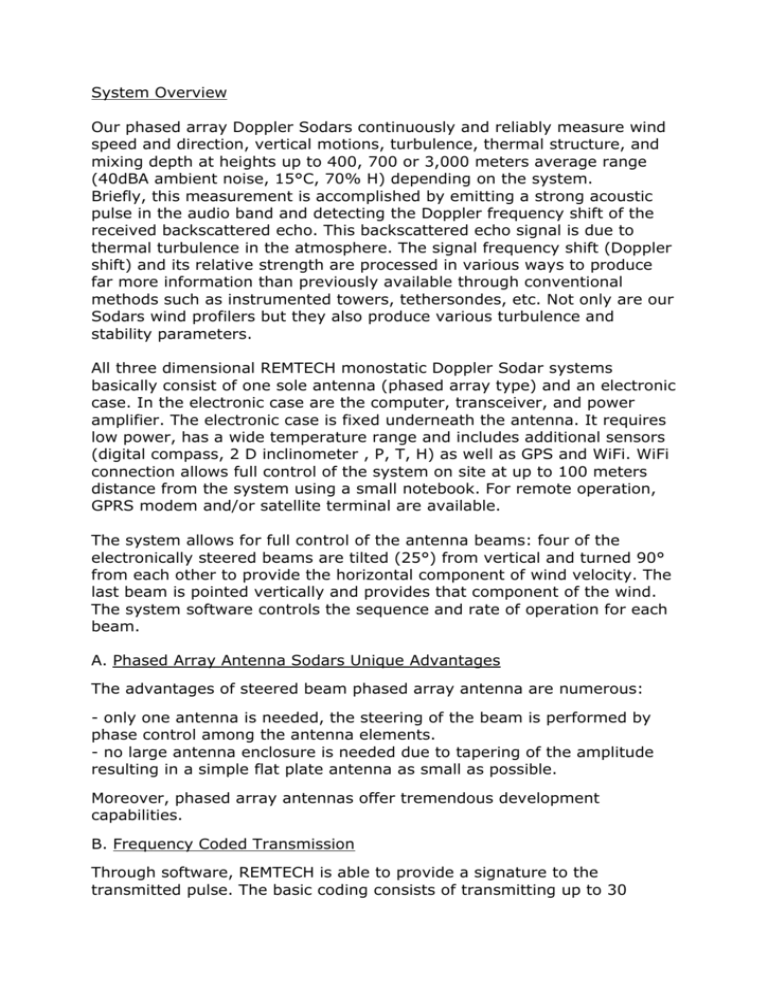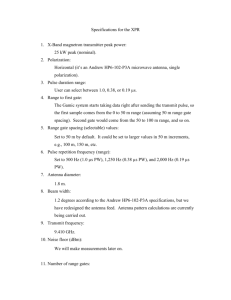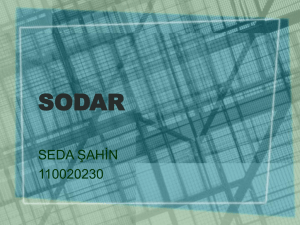System Overview Our phased array Doppler Sodars continuously
advertisement

System Overview Our phased array Doppler Sodars continuously and reliably measure wind speed and direction, vertical motions, turbulence, thermal structure, and mixing depth at heights up to 400, 700 or 3,000 meters average range (40dBA ambient noise, 15°C, 70% H) depending on the system. Briefly, this measurement is accomplished by emitting a strong acoustic pulse in the audio band and detecting the Doppler frequency shift of the received backscattered echo. This backscattered echo signal is due to thermal turbulence in the atmosphere. The signal frequency shift (Doppler shift) and its relative strength are processed in various ways to produce far more information than previously available through conventional methods such as instrumented towers, tethersondes, etc. Not only are our Sodars wind profilers but they also produce various turbulence and stability parameters. All three dimensional REMTECH monostatic Doppler Sodar systems basically consist of one sole antenna (phased array type) and an electronic case. In the electronic case are the computer, transceiver, and power amplifier. The electronic case is fixed underneath the antenna. It requires low power, has a wide temperature range and includes additional sensors (digital compass, 2 D inclinometer , P, T, H) as well as GPS and WiFi. WiFi connection allows full control of the system on site at up to 100 meters distance from the system using a small notebook. For remote operation, GPRS modem and/or satellite terminal are available. The system allows for full control of the antenna beams: four of the electronically steered beams are tilted (25°) from vertical and turned 90° from each other to provide the horizontal component of wind velocity. The last beam is pointed vertically and provides that component of the wind. The system software controls the sequence and rate of operation for each beam. A. Phased Array Antenna Sodars Unique Advantages The advantages of steered beam phased array antenna are numerous: - only one antenna is needed, the steering of the beam is performed by phase control among the antenna elements. - no large antenna enclosure is needed due to tapering of the amplitude resulting in a simple flat plate antenna as small as possible. Moreover, phased array antennas offer tremendous development capabilities. B. Frequency Coded Transmission Through software, REMTECH is able to provide a signature to the transmitted pulse. The basic coding consists of transmitting up to 30 frequencies in the pulse (15 on each of the two symetrical tilted beams in the same vertical plane). Upon reception, this coded pulse is easily detected from noise and fixed echoes within the backscattered signal. This is particularly useful for turbulence studies since it allows quicker detection for full analysis on the noise spectrum. The technique has been used for years in radar, REMTECH is still the only company to apply this to SODAR (US Patent No 5,521,883). C. Automatic Fixed Echo Detection Though the antenna pattern is optimized relative to fixed echoes, some of these can still be strong enough to spoil the returned signals. In this case the software automatically detects the fixed echoes and, according to the ratio between fixed echo intensity and useful signal, either processes the data with adequate corrections or invalidates them. D. Unique Noise Subtraction Technique The frequency transfer function (in phase and amplitude) between the "active antenna" and the "reference antenna" (made of 4 transducers at the 4 antenna corners) allows a very efficient noise subtraction, especially for a fixed noise source such as an air conditioner or an aspirated shield on a meteorological tower close to the sodar. The final acoustic frequency power spectrum can be cleaned by more than 15dB’s decrease of the jamming source in the considered frequency zone. This noise subtraction technique is also very efficient to removing spurious frequency peaks which can be generated by electrical and/or magnetic influence. E. “Apparent” angle of arrival technique By computing the angle of arrival of the different backscattered signals we are able to differentiate between widely spread noise sources and point noise sources and also between real signals and ground clutter. All this is equivalent to a significant increase in signal to noise ratio. F. Frequency spread of the useful signals Real backscattered signals exhibit a rather wide spectral broadening range. By carefully screening the acoustic spectrum peaks according to their spectral broadening our systems are able to reduce significantly the false validation probability. G. Phase variation in the frequency domain of the returned signal versus frequency When a peak in the acoustic spectrum of the backscattered signal appears like a potential signal peak we check its phase signature. This again allows a significant false validation probability reduction. H. Why the Remtech Sodars do not need any editing? The rationale is to constantly keep the false validation below a given threshold. This threshold is chosen so that at the end of the averaging period the number of false validations is small enough versus the total number of validations, thus warranting the required precision. This is achieved by different means: - tracking the spurious peaks in the acoustic spectra of the backscattered signal which can be of acoustic (ventilation fan, air conditionner...), electrical (bad grounding) or magnetic (nearby high power transformer for instance) origin. - modifying in real time up to more than 1,000 signal to noise ratio thresholds (one per frequency point for each of 5 beams) so that the false probability is fully controlled. All this monitoring is done during regular time intervals while the Sodar does not emit but performs all its normal computations. In a perfect world as there has been no emission there should be no validations. In the real world there are a few and we keep their total number below a given limit as quoted above. 2. - Standard Software The raw acoustic spectra are computed using a Fast Fourier Transform (FFT). Most of the processing is done by software thus dramatically reducing the amount of transceiver hardware. The software also handles the transceiver relays which are connected to the different transducers of the antenna and perform the beamforming along the 5 (up to 9) axes (1 vertical, 4 -up to 8- tilted). In the receive mode, the backscattered signal is first processed through 2048 frequency point FFT’s. All REMTECH Doppler Sodar systems are provided with the following features : - Frequency Coded Transmission - Fast Fourier Transform Doppler Detection by software - Automatic Fixed Echo Detection - Data output on solid state - Automatic real-time data validation - Standard display and recording of: . echo strength . wind speed . wind direction . vertical speed. 3. - Some Software Options . Sigma W Software Computes the vertical wind speed standard deviation in real time. Sigma w is corrected for individual measurement error using the frequency coding approach. . Sigma Theta Software The standard deviation of horizontal wind direction is computed in real time. . Automatic Inversion Detection Routine This routine uses pattern recognition algorithms which are applied to backscattered signal, wind components and turbulence vertical profiles. The output is a direct read-out of inversion height accomplished in real time. A success rate greater than 90% is experienced at most sites. This routine requires sigma w and sigma theta software options to function. . Automatic Mixing Height Calculation Provides an estimation of the mixing height in real time by using a spectral analysis of the vertical component time series at different levels. Needs sigma w and sigma theta routines. . Automatic Stability Classification Routine This is a real time direct determination of stable/neutral/unstable categories as a function of height and time. Pattern recognition algorithms using echo profiles, wind, wind shear (pseudo "Bulk Richardson" approach). Needs sigma w, sigma theta and automatic inversion detection routines. . Temperature Lapse Rate Estimation Provides an estimation of the temperature lapse rate in real time. Requires sigma w, sigma theta, and automatic inversion detection routines. 4. - Specifications Number of range gates * (selectable) 100 (300 optional) Thickness of each gate* 5 to 200 meters, in 1 meter layer increments Averaging period * 2 mn (1mn optional) to 1 hour Initial processing Horizontal wind speed range 1024 or 2048 frequency point FFT’s by software Signal/noise ratio continuously measured and used for validation 0 to 30 m/sec Horizontal speed accuracy Better than 0.2 m/sec or 3 % for wind speed over 6 m/sec Vertical speed range - 4 to + 4 m/sec (± 12 m/s optional) Vertical speed accuracy 5 cm/sec or better Background noise correction Horizontal direction accuracy 3° or better for winds faster accuracy than 2 m/s. * Parameters easily changed remotely Accuracies correspond to the limits of our validation criteria, therefore accuracies are usually better.




